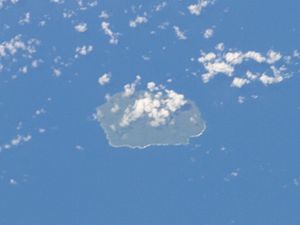Late (Tonga)
| Late | |
|---|---|
| ISS photo of the island | |
| Waters | Pacific Ocean |
| Archipelago | Tonga Islands |
| Geographical location | 18 ° 48 '13 " S , 174 ° 38' 38" W |
| length | 5.3 km |
| width | 4.4 km |
| surface | 18.5 km² |
| Highest elevation | 540 m |
| Residents | uninhabited |
Late is an uninhabited volcanic island in the Pacific that belongs to the Kingdom of Tonga . The roughly circular island lies along the volcanic Tofua island arc, about 55 kilometers southwest of the island of Vava'u . It has a diameter between 4.4 and 5.3 kilometers and an area of 18.5 km², according to other sources 17.4 km². It has a 400 m wide and 140 m deep volcanic crater with a short-lived lake. The lying largely under water, of basalt and andesite existing stratovolcano rises to about 1,500 meters from the seabed. Its conical summit rises 540 m above sea level. At the summit of the crater, in the plateaus around 100 to 150 meters north and west of the crater, several cinder cones can be found. In the northeast of the island there is a trench structure with two pit craters , one of which is partially filled with a salt water lake. In historical times there were volcanic eruptions in 1790 and 1854 . Both eruptions occurred in the northeast of the island, possibly creating lava flows .
The island was inhabited until the middle of the 19th century; Descendants of the inhabitants now live on the island of Hunga in the Vavaʻu group. Before 1991, kava plantations were mainly planted in the northwest of the island . Occasionally, smaller groups of people would stay on the island to work in the plantations.
Late is one of the few islands in the South Pacific that still has a more stable population of purple shoulder pigeons. This species is classified as endangered ( vulnerable ) by the IUCN .
Web links
- Late in the Global Volcanism Program of the Smithsonian Institution (English)
Individual evidence
- ↑ Dieter R. Rinke: Birds of 'Ata and Late, and additional notes on the avifauna of Niuafo'ou, Kingdom of Tonga. In: Notornis 38 (2), pp. 131–151, here p. 132 (PDF, 969 kB).
- ^ UNEP Islands
- ↑ Rinke: Birds (PDF; 992 kB) , p. 133.
- ↑ BirdLife Factsheet , Accessed July 4, 2009

